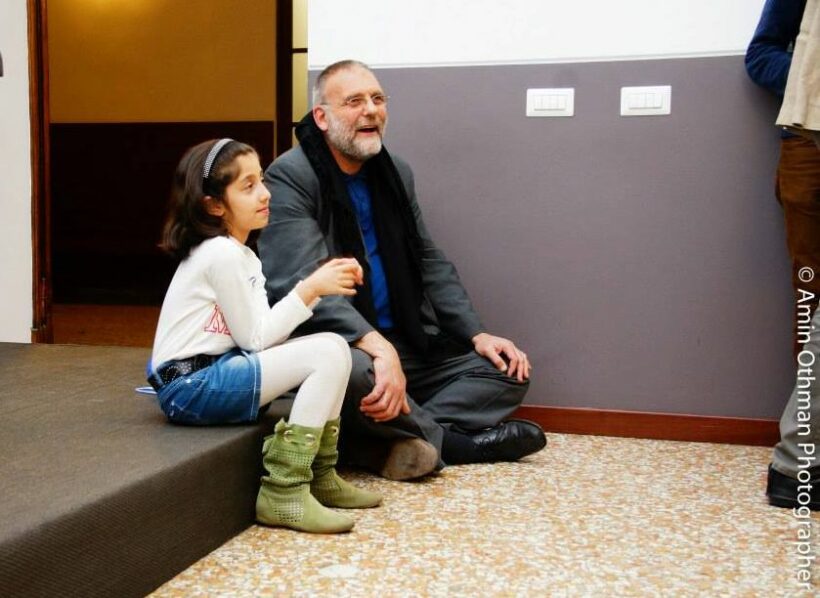It seems like yesterday and yet ten years, 120 months, 40 seasons have passed since our last messages… mine and those of Abuna Paolo (Father Paolo Dall’Oglio). July 2013, I was in Trieste, worried about the health of Edvino (Ugolini, a sensitive poet of Peace). Paolo was in Kurdistan during Ramadan. Thinking of the dear friend who was suffering a lot, he suggested the verses of “La Carità” (Charity) by Saint Paul, concluding his writing with “We are kneaded with eternity and put to cook in the oven of time to be cooked by the fire of Love”. Then there was silence between us!
I started following peace projects after falling in love with two words “Peace and Nonviolence”. My territory of action is Bresciano, part of my origins. Here there is a military airport where it is assumed that there are 20 atomic warheads. Going to the first edition of the World March for Peace and Nonviolence (2/10/2009-2/1/2010), I discovered that inside the garden of the Museum of Santa Giulia in Brescia grows a Hibakujumoku (translator’s note: a Hibakujumoku is a tree that survived the atomic bombing of Hiroshima and Nagasaki) from Nagasaki, the descendant of a persimmon tree that survived the atomic attack of August 9, 1945. Thanks to the care of Dr. Masayuki Ebinuma (doctor of trees) , fruits were born whose seeds gave the first seedlings adopted by primary school children in Japan. Thanks to the artist Tatsuo Miyajima who told this story of the rebirth of life during the 1999 Venice Biennale, the Kaki Tree Project has spread throughout Italy, especially in the province of Brescia. In June 2012, taken by the enthusiasm of having managed to get a Nagasaki persimmon to the Garden of Peace and Hope in Kabul (Afghanistan), but above all by the dramatic news that was starting to arrive from Syria, I set off “on the road” to try to get a Tree of Peace there as well. This is how I came into contact with Father Paolo Dall’Oglio and the monastic community Deir Mar Musa (San Moses the Abyssinian). At that moment he had just been expelled from Syria after thirty years for openly siding against the Assad government.
An intense correspondence began between us which ended with his kidnapping. Paulo told me about his journey in that over 1 500-year-old monastery 1 300 meters up the mountains facing Nebek. The stable refoundation of the monastic community began in 1991. The priority was the rediscovery of the absolute and non-instrumental meaning of the spiritual life, of the life of prayer. In this respect, the ancient Syrian monastery was a strong witness to the value of spiritual life in the region’s past, but also to the risk of losing this value. The ancient oriental monastic life is an essential element of the Christian soul and also of the cultural, symbolic and mystical world of Islam. The community of Deir Mar Musa was therefore above all a community of silence and prayer, both in the personal life of the monks and nuns and in their social life. It was therefore necessary to develop a life of evangelical simplicity in responsible harmony with the creation and the surrounding society, and involving the rediscovery of the meaning of manual activity and of the value of the body and of objects, in an aesthetic of justice and voluntarism; and then [also of] hospitality, the Abrahamic one (a sacred activity of the ancient monks, based on a value always considered divine in this region). The monastery, therefore, is understood as a meeting place, in the deepening, not in the oblivion, of the specificities of identity. [It is] not, however, in view of the closure but, on the contrary, in the emancipation from a culture of separation, [and] to elaborate instead, gradually, a culture of communion. This also implied that the Christian community of Deir Mar Musa places a strong emphasis on the ecumenical dimension, that is, of communion and unity between the Churches, without losing anything of the Syriac and also Syro-Catholic specificity of the monastery itself. The horizon is that of the Islamic-Christian relationship with the choice of the Arabic language as the language in the social and liturgical life of the community. So, a stop on the “Abraham’s journey”.
In his travels between the two summers of 2012-2013 Paolo told me “Let’s wait confidently… By now the dimension of the atomic tragedy is beginning to be the same as that of the Syrian tragedy. So the Japanese resurrection speaks to us ”, the rebirth of life witnessed by the persimmon tree of Nagasaki waiting to (finally) reach his destination (Deir Mar Musa).
On Saturday 29 July [2023], exactly ten years after Paolo’s abduction in Syria, at 17:00 at the Church of Sant’Ignazio in Rome there was the presentation of the book “My Testament”, published by ITL Libri (under the brand Centro Ambrosiano). The volume contains the unpublished conferences held by Father Dall’Oglio in the months before his expulsion from Syria; a work that reveals a vision open to new horizons of ecumenism, fraternity and dialogue with Islam. These themes are also dear to Pope Francis, who signed the preface.
The event was punctuated by interventions by authoritative witnesses who knew him closely, such as Father Jihad Youssef (superior of the Deir Mar Musa monastic community), Adib al-Khoury, director of the Deir Mar Musa Community publishing house, Elena Bolognesi, editor and translator of the text, and Giovanni Dall’Oglio, father Paolo’s brother, who spoke on behalf of the family.
At 19.00, after the presentation, there was a Eucharistic celebration presided over by the Vatican Secretary of State, Cardinal Pietro Parolin, to honor the memory of Father Paolo and to renew his commitment to the ideals of peace and dialogue with all.










